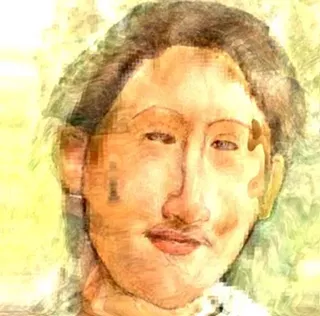Sit down with him and feed him a cookie, and he'll expound at length on the history of mime, the philosophy of mime and how he's different from your corner mime-in-a-box.
"I'm interested in mime as an actor's craft, more than as shtick and music-hall entertainment and pulling imaginary ropes," he says. "What I do is an ensemble art form, on a stage, in a theater, played by actors who know how to express emotion and changes in psychology through the body. And we deal with larger themes than getting out of an invisible box--love, hate, loss, grief."
Wamer's group is called, a little redundantly, Theatrical Mime Theatre, emphasizing that mime can be far more than amusing street entertainment by rubber-limbed performers in whiteface.
Wamer has been in the mime biz for 24 years, touring six to nine months each year and serving as co-director of the School for Mime Theatre in Gambier, Ohio. He'd studied there in the 1980s, back when it was called the Goldston & Johnson School for Mime. Wamer also studied with Marcel Marceau, later assisting him in seminars, and more recently with the Polish mime Stefan Niedzialkowski.
"I get my technique from Marcel Marceau," says Wamer, "and my metaphysics from Stefan Niedzialkowski."
Wamer settled in Tucson three years ago, teaching mime and theater to local kids and adults (most steadily at Booth Fickett Middle School). In late February, he produced the debut performance by Theatrical Mime Theatre in collaboration with Lorie Heald, his artistic and romantic partner, with guest artists and original music played live by the William Campbell Group.
This weekend, Wamer will offer a solo show called "Geometries: Performing Art Experiments by a Not-So Mathematical Genius." It's a program of "mime poems" and even some spoken monologues.
In "Geometries," each character must deal somehow with major stress.
"Some succumb to it," Wamer says, "but some find interesting and surprising ways through it, so they can continue to function. Coping with stress has been one of the major themes that's run through my life."
"Geometries" is a small-scale show intended to hook people on Wamer's form of mime, along the way to creating a larger troupe that could mount mime versions of, say, Shakespeare's The Tempest or Dickens' A Christmas Carol, or wholly original work using unexpected physical imagery.
"Mime can use imagery that compresses thought, time, idea and emotion into intense moments of sculptural movement," he says. "Through the density and quality of movement, we're trying to create an art form that can move the theater-going audience deeply, something they can engage with and not just stand and watch for two minutes, something that will send them away emotionally transformed."
Wamer emphasizes that he doesn't mean to dismiss street mimes; that's just not what he wants to do with his life.
"What brings people to mime--what brought me to it when I was a kid--is beautiful and clear technical illusion--the wall, the box, walking into the wind," he says. "But your goal as an actor is not to create a cool illusion.
"There is major value in street performance. You learn how to hold an audience. You learn what it is you need in your craft so that audience members passing by with their own agendas can be compelled to stay and watch you. If you learn that on the street, there's nothing you can't do on stage."
Wamer hopes to have a high-level troupe mounting a big production as early as next spring; participants would be actors, dancers, even children.
"Anyone delighted by the fantasy of it," he says. "Eventually, I'd also like to have a youth ensemble that creates high-caliber works of theater; that could transform kids' lives."








